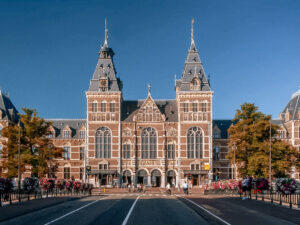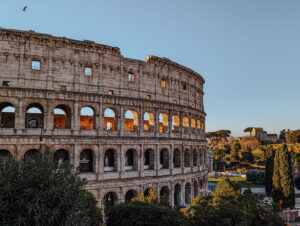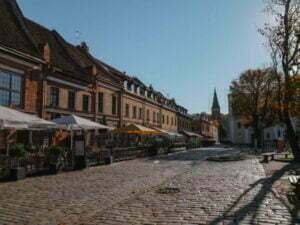Growing up, we learned about the Holocaust in grade school, but the courses we and many of our friends had didn’t cover many details about the horrors of this era in the Baltic region of Europe. Kaunas has numerous forts, but the Ninth Fort of Kaunas contains a museum that covers much of this dark part of Lithuania’s past. If you find yourself in the city, this is a spot you should definitely visit to learn about the fort system and an important aspect of the country’s history.
History of the Ninth Fort of Kaunas
In the early 1900s, the Ninth Fort of Kaunas was built. This was one of several forts constructed to protect the city from attacks and intruders. During this time, Kaunas was under Russian rule and the area was under constant attack by German forces during WWI. Russians retreated and Lithuania declared its independence in 1918.
The fort was converted into a hard-labor prison where prisoners conducted mostly agricultural work. Lithuania was taken over by the Soviets in 1940 and the prison became a temporary holding space before prisoners were transferred to camps in the heart of the Soviet Union.
War again broke out in the area and the Germans took control of Kaunas in 1941. Not long afterwards, officials began killing Jewish representatives in Kaunas. The Ninth Fort was used to detain Jewish individuals from Lithuania and many others who were transported there from countries all around Europe. The mass murders of men, women, and children followed. It is estimated that around 50,000 people were killed at the Ninth Fort of Kaunas during WWII.
Towards the end of the war, the Nazis attempted to hide the atrocities that had taken place at the fort by forcing current prisoners to dig up the mass graves and burn remains. Knowing death would likely face them afterwards, the prisoners organized a successful escape. The stories of the horrors of the Ninth Fort were then passed from the survivors to the world outside.
Construction of the memorial began in the 1970s and it was opened to the public in 1984.
Some of the topics covered at the Ninth Fort of Kaunas are horrific and difficult to fathom, but this period of human history is incredibly important to learn about and one we mustn’t forget.

Getting to the Ninth Fort of Kaunas
The Ninth Fort of Kaunas sits around 10km (6.2mi) from the heart of Kaunas. If you have your own transport, there are a couple road signs guiding you there and there is ample parking in the lot near the museum.
If you are taking public transport, bus 57 will take you to the fort. Click here to see timetables and stops. There are also other public buses that stop nearby. Our bus dropped us off at the 9-ojo Forto Muziejus stop – buses 23 and 35 stop here. It cost less than a Euro for a one-way ticket. We recommend downloading the Žiogas app if you’re going to be exploring a lot of Kaunas and using buses frequently. From the stop, we followed the street up towards the highway, headed right down Šeduvos Street, and then followed a path to a pedestrian walkway that brought us to the museum.
Lastly, there are taxi services and Bolt (similar to Uber), but this is more expensive than taking public transport.
General Info
Tickets to enter the museum cost 8 Euros per adult. Entry is free on the last Sunday of each month.
There are guided tours offered here for an extra cost as well. For access to certain areas of the museum, like the underground galleries, a guide is required. Tours must be pre-booked unless you join an organized tour on weekend days. For more information on tours, click here. Visitors can access the monument and grounds around the fort free of charge.
Hours
April through September:
- Monday: Closed
- Tuesday through Friday: 9 a.m. – 5 p.m.
- Saturday and Sunday: 9 a.m. – 6 p.m.
October through March:
- Monday: Closed
- Tuesday through Sunday: 9 a.m. – 5 p.m.
Check the website for updates on holiday hours, exhibition closures, etc. The grounds around the museum are open to the public 24/7. There are pretty paths, ponds, and the huge memorial.
Most importantly, thousands of people have been killed here. Please be respectful as you walk the grounds and make your way through the museum.

Exploring the Ninth Fort of Kaunas
There are multiple areas of the Ninth Fort of Kaunas to see when you visit. We spent a few hours here, which didn’t even include the Occupation Exhibition since it was closed. Additionally, we didn’t take a guided tour. If you take your time to go through the exhibits in the fort and see the memorial outside, we recommend setting aside a half day for this activity.
The Grounds & Memorial
Surrounding the Ninth Fort of Kaunas are open, grassy fields with paths winding through them connecting the museum, fort, monument, administrative building, and parking. As you walk the grounds you can see some old trees that were planted here during the time when the fort was a labor prison. Paths also lead around the fort, allowing you to see some of how it is laid out.
A wide, open space just to the west of the fort is the location where thousands were killed. The huge monument consisting of three sculptures designed by Alfonsas Vincentas Ambraziūnas, Gediminas Baravykas, and Vytautas Vielius stands just nearby.

The Occupation Exhibitions
The Occupation Exhibitions were sadly closed for renovations when we visited. As of 2025, it seems as though they reopened.
This building also holds the ticket office.
The Fort
During our visit, we headed to the fort to purchase our tickets since the other building was closed. After registering, we began making our way through the exhibits. The first rooms we went through covered the construction of the fortress and some military equipment used during times when the fort was actually used as a fortress. At the time of its construction, the Ninth Fort was quite advanced.
We made our way further into the fort and the exhibits began to cover some of what life was like in the prison, the horrors of what the Jewish community endured, and the famous prison escape. The displays are set in the former prison cells and rooms of the fort. Some of the rooms played clips while others displayed items found in the prison. One of the rooms even had original engravings carved into the wall by Jewish prisoners who were brought here from France, Poland, and other countries.
As mentioned earlier, the topics displayed in the museum are very heavy. But the history is important and a visit to the Ninth Fort makes for an interesting half-day activity in Kaunas.
Like this Post? Pin it!




